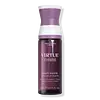What's inside
What's inside
 Key Ingredients
Key Ingredients

 Benefits
Benefits

 Concerns
Concerns

 Ingredients Side-by-side
Ingredients Side-by-side

Water
Skin ConditioningSodium Cocoyl Isethionate
CleansingSodium Lauroyl Methyl Isethionate
CleansingCocamidopropyl Betaine
CleansingGlycerin
HumectantSodium Methyl Cocoyl Taurate
CleansingCocamide Mipa
EmulsifyingKeratin
Skin ConditioningPanthenol
Skin ConditioningCentella Asiatica Meristem Cell Culture
AntioxidantAdansonia Digitata Seed Oil
EmollientPalmitamidopropyltrimonium Chloride
Coconut Acid
CleansingPEG-200 Hydrogenated Glyceryl Palmate
CleansingSodium Chloride
MaskingGuar Hydroxypropyltrimonium Chloride
Skin ConditioningPolyquaternium-7
PEG-7 Glyceryl Cocoate
EmulsifyingEthylhexylglycerin
Skin ConditioningSodium Dilauramidoglutamide Lysine
HumectantXanthan Gum
EmulsifyingParfum
MaskingPropanediol
SolventPhenoxyethanol
PreservativeChlorphenesin
AntimicrobialDisodium EDTA
Citric Acid
BufferingSodium Benzoate
MaskingBenzyl Alcohol
PerfumingPotassium Sorbate
PreservativeSodium Hydroxide
BufferingWater, Sodium Cocoyl Isethionate, Sodium Lauroyl Methyl Isethionate, Cocamidopropyl Betaine, Glycerin, Sodium Methyl Cocoyl Taurate, Cocamide Mipa, Keratin, Panthenol, Centella Asiatica Meristem Cell Culture, Adansonia Digitata Seed Oil, Palmitamidopropyltrimonium Chloride, Coconut Acid, PEG-200 Hydrogenated Glyceryl Palmate, Sodium Chloride, Guar Hydroxypropyltrimonium Chloride, Polyquaternium-7, PEG-7 Glyceryl Cocoate, Ethylhexylglycerin, Sodium Dilauramidoglutamide Lysine, Xanthan Gum, Parfum, Propanediol, Phenoxyethanol, Chlorphenesin, Disodium EDTA, Citric Acid, Sodium Benzoate, Benzyl Alcohol, Potassium Sorbate, Sodium Hydroxide
Water
Skin ConditioningKeratin
Skin ConditioningMethyl Nicotinate
SoothingAcetyl Tetrapeptide-3
Skin ProtectingZingiber Officinale Root Extract
MaskingPisum Sativum Extract
Skin ConditioningNasturtium Officinale Extract
PerfumingMoringa Oleifera Seed Extract
Skin ConditioningJasminum Officinale Flower Extract
MaskingHydrolyzed Linseed Extract
Skin ConditioningHydrolyzed Hibiscus Esculentus Extract
Skin ConditioningHelianthus Annuus Seed Extract
Skin ConditioningDaucus Carota Sativa Root Extract
Skin ConditioningCynara Scolymus Leaf Extract
Skin ConditioningAmaranthus Caudatus Seed Extract
Skin ConditioningSaccharomyces Lysate Extract
HumectantLarix Europaea Wood Extract
HumectantTrifolium Pratense Flower Extract
AstringentCamellia Sinensis Leaf Extract
AntimicrobialIsochrysis Galbana Extract
Skin ConditioningTocopherol
AntioxidantMentha Piperita Oil
MaskingDextran
Pentylene Glycol
Skin ConditioningSodium Phytate
Sodium Dilauramidoglutamide Lysine
HumectantQuaternium-51
Ethylhexylglycerin
Skin ConditioningSodium Metabisulfite
AntioxidantGlycine
BufferingParfum
MaskingBiosaccharide Gum-4
Skin ConditioningButylene Glycol
HumectantGlycerin
HumectantZinc Chloride
AntimicrobialPPG-26-Buteth-26
Skin ConditioningPropanediol
SolventPolyacrylate Crosspolymer-6
Emulsion StabilisingPEG-40 Hydrogenated Castor Oil
EmulsifyingT-Butyl Alcohol
PerfumingAlcohol
AntimicrobialTetrasodium EDTA
Sodium Benzoate
MaskingPotassium Sorbate
PreservativeDisodium EDTA
Phenoxyethanol
PreservativeCitric Acid
BufferingLinalool
PerfumingGeraniol
PerfumingLimonene
PerfumingCitronellol
PerfumingBenzyl Benzoate
AntimicrobialCitral
PerfumingHexyl Cinnamal
PerfumingWater, Keratin, Methyl Nicotinate, Acetyl Tetrapeptide-3, Zingiber Officinale Root Extract, Pisum Sativum Extract, Nasturtium Officinale Extract, Moringa Oleifera Seed Extract, Jasminum Officinale Flower Extract, Hydrolyzed Linseed Extract, Hydrolyzed Hibiscus Esculentus Extract, Helianthus Annuus Seed Extract, Daucus Carota Sativa Root Extract, Cynara Scolymus Leaf Extract, Amaranthus Caudatus Seed Extract, Saccharomyces Lysate Extract, Larix Europaea Wood Extract, Trifolium Pratense Flower Extract, Camellia Sinensis Leaf Extract, Isochrysis Galbana Extract, Tocopherol, Mentha Piperita Oil, Dextran, Pentylene Glycol, Sodium Phytate, Sodium Dilauramidoglutamide Lysine, Quaternium-51, Ethylhexylglycerin, Sodium Metabisulfite, Glycine, Parfum, Biosaccharide Gum-4, Butylene Glycol, Glycerin, Zinc Chloride, PPG-26-Buteth-26, Propanediol, Polyacrylate Crosspolymer-6, PEG-40 Hydrogenated Castor Oil, T-Butyl Alcohol, Alcohol, Tetrasodium EDTA, Sodium Benzoate, Potassium Sorbate, Disodium EDTA, Phenoxyethanol, Citric Acid, Linalool, Geraniol, Limonene, Citronellol, Benzyl Benzoate, Citral, Hexyl Cinnamal
 Reviews
Reviews

Ingredients Explained
These ingredients are found in both products.
Ingredients higher up in an ingredient list are typically present in a larger amount.
Citric Acid is an alpha hydroxy acid (AHA) naturally found in citrus fruits like oranges, lemons, and limes.
Like other AHAs, citric acid can exfoliate skin by breaking down the bonds that hold dead skin cells together. This helps reveal smoother and brighter skin underneath.
However, this exfoliating effect only happens at high concentrations (20%) which can be hard to find in cosmetic products.
Due to this, citric acid is usually included in small amounts as a pH adjuster. This helps keep products slightly more acidic and compatible with skin's natural pH.
In skincare formulas, citric acid can:
While it can provide some skin benefits, research shows lactic acid and glycolic acid are generally more effective and less irritating exfoliants.
Most citric acid used in skincare today is made by fermenting sugars (usually from molasses). This synthetic version is identical to the natural citrus form but easier to stabilize and use in formulations.
Read more about some other popular AHA's here:
Learn more about Citric AcidDisodium EDTA plays a role in making products more stable by aiding other preservatives.
It is a chelating agent, meaning it neutralizes metal ions that may be found in a product.
Disodium EDTA is a salt of edetic acid and is found to be safe in cosmetic ingredients.
Learn more about Disodium EDTAEthylhexylglycerin (we can't pronounce this either) is commonly used as a preservative and skin softener. It is derived from glyceryl.
You might see Ethylhexylglycerin often paired with other preservatives such as phenoxyethanol. Ethylhexylglycerin has been found to increase the effectiveness of these other preservatives.
Glycerin is already naturally found in your skin. It helps moisturize and protect your skin.
A study from 2016 found glycerin to be more effective as a humectant than AHAs and hyaluronic acid.
As a humectant, it helps the skin stay hydrated by pulling moisture to your skin. The low molecular weight of glycerin allows it to pull moisture into the deeper layers of your skin.
Hydrated skin improves your skin barrier; Your skin barrier helps protect against irritants and bacteria.
Glycerin has also been found to have antimicrobial and antiviral properties. Due to these properties, glycerin is often used in wound and burn treatments.
In cosmetics, glycerin is usually derived from plants such as soybean or palm. However, it can also be sourced from animals, such as tallow or animal fat.
This ingredient is organic, colorless, odorless, and non-toxic.
Glycerin is the name for this ingredient in American English. British English uses Glycerol/Glycerine.
Learn more about GlycerinKeratin is a protein naturally found in our hair and skin.
In haircare, it has been shown to seal broken cuticles. This can help prevent breakage and split ends.
Parfum is a catch-all term for an ingredient or more that is used to give a scent to products.
Also called "fragrance", this ingredient can be a blend of hundreds of chemicals or plant oils. This means every product with "fragrance" or "parfum" in the ingredients list is a different mixture.
For instance, Habanolide is a proprietary trade name for a specific aroma chemical. When used as a fragrance ingredient in cosmetics, most aroma chemicals fall under the broad labeling category of “FRAGRANCE” or “PARFUM” according to EU and US regulations.
The term 'parfum' or 'fragrance' is not regulated in many countries. In many cases, it is up to the brand to define this term.
For instance, many brands choose to label themselves as "fragrance-free" because they are not using synthetic fragrances. However, their products may still contain ingredients such as essential oils that are considered a fragrance by INCI standards.
One example is Calendula flower extract. Calendula is an essential oil that still imparts a scent or 'fragrance'.
Depending on the blend, the ingredients in the mixture can cause allergies and sensitivities on the skin. Some ingredients that are known EU allergens include linalool and citronellol.
Parfum can also be used to mask or cover an unpleasant scent.
The bottom line is: not all fragrances/parfum/ingredients are created equally. If you are worried about fragrances, we recommend taking a closer look at an ingredient. And of course, we always recommend speaking with a professional.
Learn more about ParfumPhenoxyethanol is a preservative that has germicide, antimicrobial, and aromatic properties. Studies show that phenoxyethanol can prevent microbial growth. By itself, it has a scent that is similar to that of a rose.
It's often used in formulations along with Caprylyl Glycol to preserve the shelf life of products.
Potassium Sorbate is a preservative used to prevent yeast and mold in products. It is commonly found in both cosmetic and food products.
This ingredient comes from potassium salt derived from sorbic acid. Sorbic acid is a natural antibiotic and effective against fungus.
Both potassium sorbate and sorbic acid can be found in baked goods, cheeses, dried meats, dried fruit, ice cream, pickles, wine, yogurt, and more.
You'll often find this ingredient used with other preservatives.
Learn more about Potassium SorbatePropanediol is an all-star ingredient. It softens, hydrates, and smooths the skin.
It’s often used to:
Propanediol is not likely to cause sensitivity and considered safe to use. It is derived from corn or petroleum with a clear color and no scent.
Learn more about PropanediolSodium Benzoate is a preservative. It's used in both cosmetic and food products to inhibit the growth of mold and bacteria. It is typically produced synthetically.
Both the US FDA and EU Health Committee have approved the use of sodium benzoate. In the US, levels of 0.1% (of the total product) are allowed.
Sodium benzoate works as a preservative by inhibiting the growth of bacteria inside of cells. It prevents the cell from fermenting a type of sugar using an enzyme called phosphofructokinase.
It is the salt of benzoic acid. Foods containing sodium benzoate include soda, salad dressings, condiments, fruit juices, wines, and snack foods.
Studies for using ascorbic acid and sodium benzoate in cosmetics are lacking, especially in skincare routines with multiple steps.
We always recommend speaking with a professional, such as a dermatologist, if you have any concerns.
Learn more about Sodium BenzoateWe don't have a description for Sodium Dilauramidoglutamide Lysine yet.
Water. It's the most common cosmetic ingredient of all. You'll usually see it at the top of ingredient lists, meaning that it makes up the largest part of the product.
So why is it so popular? Water most often acts as a solvent - this means that it helps dissolve other ingredients into the formulation.
You'll also recognize water as that liquid we all need to stay alive. If you see this, drink a glass of water. Stay hydrated!
Learn more about Water